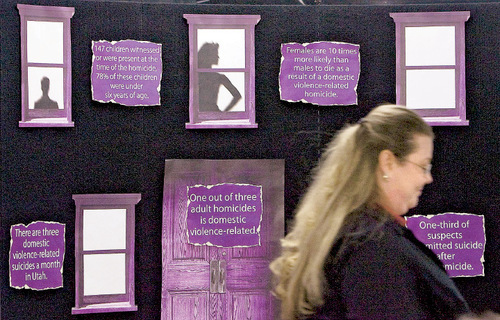This is an archived article that was published on sltrib.com in 2010, and information in the article may be outdated. It is provided only for personal research purposes and may not be reprinted.
If state officials were to put a face on a domestic-violence murder victim in Utah, it would be that of a married Latino woman who'd been with her partner eight years before being shot to death at home.
That portrait comes from a new report released Tuesday by the Utah Department of Health's Violence and Injury Prevention Program and highlights, among other findings, the need to reach out to underserved communities, officials said.
While Latinos make up less than 10 percent of the state's population, they accounted for 77 percent of domestic-violence-related deaths between 2003 and 2008, the report said. American Indians and blacks were also overrepresented in the death tallies.
"That is a huge concern for us," said Hildegard Koenig, diversity coordinator at the Utah Domestic Violence Coalition. "There are a lot of myths that serve to isolate [Latino] victims even more."
Latino women may be less likely to seek help because of cultural dynamics that emphasize family connectedness, distrust of the legal system, language barriers and fear of deportation, the report said.
The report used data culled from death certificates, medical examiners' records, police reports, crime lab reports and detailed homicide reports on all violent deaths in Utah. It also provides an in-depth look at the link between domestic violence and suicide.
Utah is one of 17 states collecting domestic-violence-related homicide data as part of a program overseen by the Centers for Disease Control and Prevention.
Between 2003 and 2008, 87 adults in Utah died in domestic-violence-related incidents — one-third of all homicides among adults during that period. A majority of the homicides — 66 — involved intimate partners who were living in the same household at the time. In many cases, friends, family members and co-workers were aware of violence involving the couple.
While men may also be victims, the report found 10 times as many females died in domestic-violence-related murders.
Men, however, were more likely to commit suicide in circumstances related to domestic violence. The state counted 165 domestic-violence-related suicides between 2005 and 2008, and nearly all were precipitated by a criminal legal problem — a court hearing, police pursuit or pending arrest.
A suicide is considered to be related to domestic violence if it involved current or past interpersonal violence or the threat of violence between intimate partners, family members or roommates.
Of those cases, 16 were murder-suicides. The suspect typically had a previous history of domestic violence, had made threats that were increasingly specific and had a history of poor mental health or substance abuse.
At a Tuesday news conference, Salt Lake City police Detective Aaron Leavitt described the lingering trauma he has experienced since responding to Lisa Pouha's murder in 2007.
The 40-year-old Salt Lake City resident was stabbed to death by her husband, Sione Talanoa. Pouha fled her home as Talanoa attacked her, and she bled to death on a driveway as neighbors, who witnessed the assault, called police. The couple had a history of domestic violence. Talanoa is serving a term of 15 years to life at Utah State Prison.
"I drive past that location on a daily basis, and there is not a day that goes by that I don't think of the violent crime that occurred there," Leavitt said. "She didn't deserve it. That is something that will stick with me for the rest of my life.
"It's not something we can say is somebody else's problem," he said. "It's our community's problem."
Nicole Williams said Tuesday she got the "jolt of reality" she needed to end a bad relationship before it got physical or police became involved. Her partner was increasingly controlling, she said, and tried to get back at her by snatching their 3-year-old son from his bed and tossing him out into the snow one evening in January 2006.
"When I saw the terrified look in my son's eyes, I realized I couldn't continue on this way," said Williams, who now works as a victims' advocate in Sandy. "If you think your children are too young to understand what is going on, they are not. Kids are more vulnerable in these situations, and they need to be protected."
Utah is one of five states that make it a crime to engage in domestic violence while children are present.
The report found that nearly half of domestic-violence-related murders involved intimate partners who lived with children. But the Utah Division of Child and Family Services was contacted in only 13 of 28 incidents, the health department said.
The report said immediate referrals should be made to DCFS, regardless of whether the children witnessed the murder, and appropriate services offered.
Other recommendations include consistent prosecution of protective-order violations and creation of a statewide task force to resolve data- and information-sharing problems and educate the public, service providers and court personnel about the dangers of intimate-partner abuse and domestic violence. —
Domestic-violence-related homicide in Utah, 2003 to 2008
There is approximately one domestic-violence-related homicide each month in Utah
One out of three adult homicides are domestic-violence homicides.
Women are 10 times more likely than men to die as a result of domestic violence.
While Latinos make up only 10 percent of Utah's population, they account for 77 percent of domestic-violence homicide victims
Nearly 68 percent of domestic-violence homicides involved a firearm
Source: Utah Department of Health's Violence and Injury Prevention Program report



